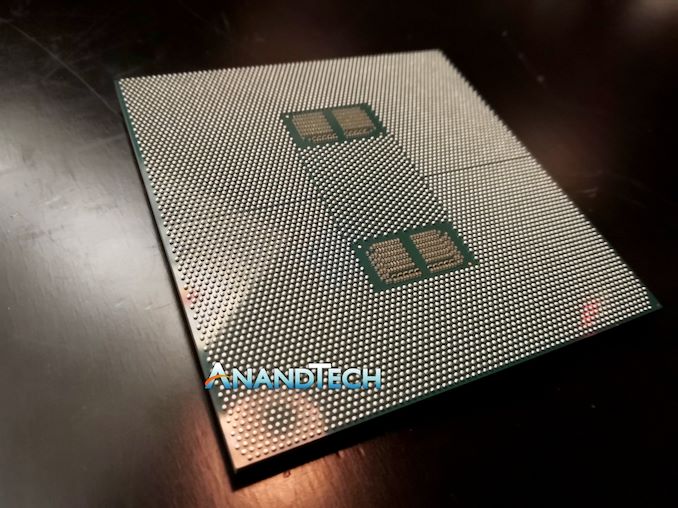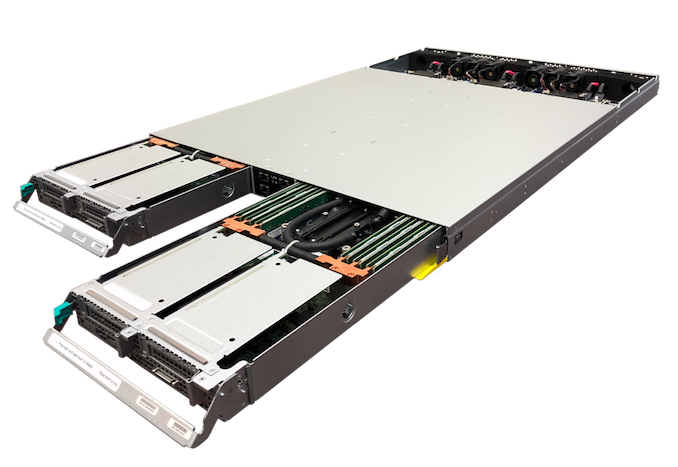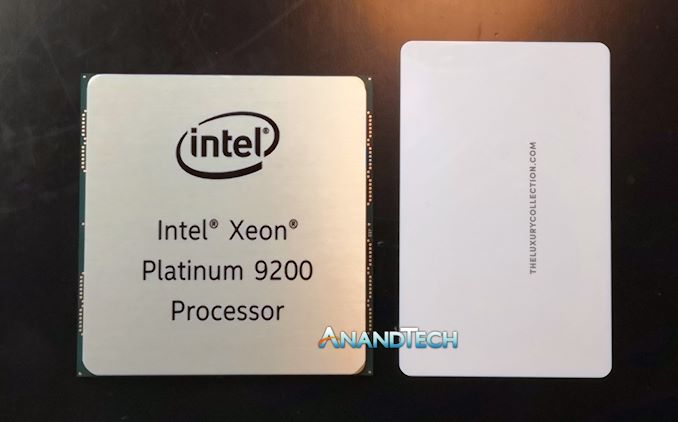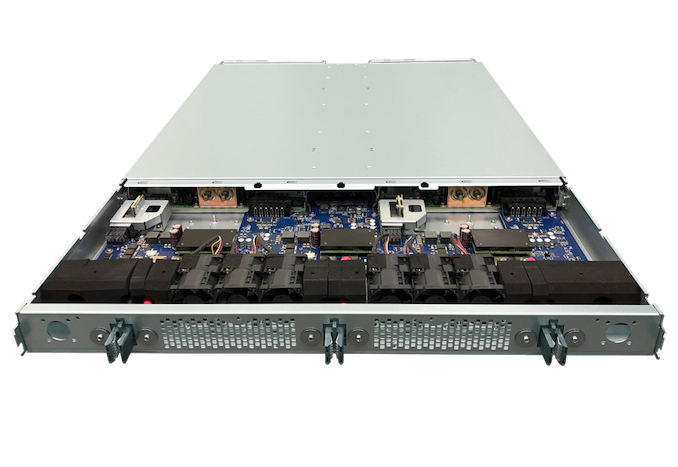Xeon Platinum 9200 at Scale: Penguin Computing’s new 7616 Cores-Per-Rack Solution
by Dr. Ian Cutress on August 3, 2020 11:00 AM EST
Some aspects of computing rely on density, and need to pack as many compute processing elements in the smallest space possible. Intel’s Xeon Platinum 9200 range was created to solve these problems, however uptake seems to be limited due to the high power consumption, suited only for those with deep pockets and the ability to deploy. Penguin Computing has introduced a new Xeon Platinum 9200 platform, called TundraAP, to enable better power efficiency and higher compute density.
Advanced Performance = Rack Density
Ever since Intel announced its ‘Advanced Performance’ computing platform, combining two high powered silicon dies in a single package for up to 56 cores and 400 W in a single socket, a lot of users have been skeptical as to the benefits. Aside from a lack of pricing, the servers were only available from Intel’s partners in a few configurations designed from Intel. Our discussions with system integrators at Supercomputing2019 indicated that there was little interest in the product, and aside from a pair of supercomputers in the TOP500 list, volumes seem to be somewhat small.
The chip is very big, and BGA only, but in the right environment, allows for 224 cores in a 1U server. According to Penguin Computing, due to power efficiency and density issues, in most 1U configurations those cores are being underutilized, and the excess idle power goes to waste or they are thermally limited. The new TundraAP platform from Penguin Computing, and its first server the Relion XO1122eAP, fits two of Intel’s S9200WK notes into a 1U system but implements it in a power disaggregation design.
This power disaggregation design removes the standard PSU location inside the server and moves it to dedicated power shelves and centralized DC busbars, such that the server receives the power when it is installed into the rack with simplified power distribution similar to back-plane, but for power. With the power supplies effectively moved elsewhere, they are no longer dumping extra heat into each of the two blades in the 1U form factor, allowing for optimized power delivery and better thermal management. This also allows the power to be managed at a rack level, compared to a per-node level.
This also benefits the types of cooling used on these chips, with Penguin Computing providing a custom direct-to-chip liquid system that enables better thermal coverage of the components that put out the most heat. It also allows cooling to be distributed and monitored at the rack level as well. The TundraAP platform makes use of the Open Compute Project form factor, to which Penguin Computing claims it can provide 15% more nodes per rack due to its better power efficiency.
These systems are set to be deployed from September. As always with Xeon Platinum 9200, the question is which customers are buying them, and exactly how much is it? Intel still refuses to put a comparative price on the Xeon 9200 series parts, instead stating that it’s a solution level product.
 Can't say no to a big chip or two
Can't say no to a big chip or two
Sources: CRN, Penguin Computing













23 Comments
View All Comments
gardendeco - Tuesday, March 16, 2021 - link
Very Nice, Blog please also seeGarden Deco https://gardendeco.in/ is One Of The Leading Gardening Brands known as Online Garden Store in India. We sell Garden Accessories Online such as metal planters, urns and coir fountains, Railing planters online India, hanging plant stand, flower pot stand, hooks and hangers. We are providing unique gardening range at affordable prices. We never Compromises with our quality. Our products are Constructed and finished with a waterproof coating that increase product life. Garden Decor Offers Garden pot stands, Pot stand for balcony, Plant stand online, Planter holder, coir hanging baskets, garden hanging basket, plant trellises and Flower pot stand in India. Garden Deco Online Garden Store - carries a vast knowledge and expertise in gardening with hanging plant stand in India, garden pot stands in India, pot stand for balcony in India, plant stand online in India, planter holder in India. Garden Deco Provides a wide range of indoor and outdoor plants, flowers and ornamental plants. Our Site – https://gardendeco.in/
Products -
https://gardendeco.in/gardening-products-online-ba...
https://gardendeco.in/product/plant-stand-with-whe...
https://gardendeco.in/product/wall-mounted-trough-...
https://gardendeco.in/product/coco-pole-plant-supp...
https://gardendeco.in/product/shepherd-hook/
https://gardendeco.in/product/garden-hanging-baske...
https://gardendeco.in/product/coir-pole-for-climbi...
https://gardendeco.in/product/wrought-iron-hanging...
https://gardendeco.in/gardening-products-online-ba...
https://gardendeco.in/product/railing-planters-onl...
https://gardendeco.in/product/hanging-plant-stand
https://gardendeco.in/product/flower-pot-stand
https://gardendeco.in/product/garden-pot-stands
https://gardendeco.in/product/pot-stand-for-balcon...
https://gardendeco.in/product/plant-stand-online
https://gardendeco.in/product/planter-holder
https://gardendeco.in/product/coir-hanging-baskets...
https://gardendeco.in/product/plant-trellises
https://gardendeco.in/product/coco-peats/
ncfsegroupofinstitutions - Wednesday, October 27, 2021 - link
NCFSE GROUP OF INSTITUTIONS https://ncfseskillindia.com is conducting Diploma, Advanced Diploma & other short term programs in the field of Industrial/General Safety, Fire & Safety Engineering, Nursery Teacher Training, Yoga teacher’s training, Digital Marketing and Early Childhood Care &Education. The aim of the organization is not only to provide high quality professional education to the students but it also provides a responsible youth to the society. Our courses are useful to gain skills & knowledge. Diploma in Nursery Teacher Training, or short form for NTT is a 1 year diploma course. The course aims at improving the overall quality of education at pre primary level and improving the quality of education. The NTT students are trained in areas like child education, teaching methodology, nursery level subjects & communication Many Industries accept these courses for the purpose of employment & promotion in service. NCFSE students have been well placed in key positions across various sectors. NTT COURSE, nursery teacher training course, ntt course in punjab, nursery teacher training course in chandigarh, ntt course in chandigarh, fire and safety course, Diploma in Fire and safety, Diploma in Fire and safety in chandigarh, fire and safety course scope in india, indian government approved fire and safety courses, ntt course scope in india, indian government approved ntt courses, Diploma in Nursery Teacher’s Training, diploma in fire and safety,The cost of education is another factor that adds up to their popularity, India being a developing country has a population which is more economically impoverished than economically enriched. The minimum eligibility criteria for the program is that the candidates are required to pass the 12th or equivalent examination in any stream with 50% marks. The admissions to this course is done mainly on the basis of merit list. Visit our site for other information https://ncfseskillindia.comShubhamhk - Wednesday, November 11, 2020 - link
I love the information you provide about -Penguin Computing’s new 7616 Cores-Per-Rack Solution-And I also a Digital Marketing Expert, the experience of 11 years at <a href="http://www.klevvrtech.com/seo-course-in-chandigarh... Klevvrtech</a>.
Shubhamhk - Wednesday, November 11, 2020 - link
I love the information you provide about -Penguin Computing’s new 7616 Cores-Per-Rack Solution-And I also a Digital Marketing Expert, the experience of 11 years at <a href="http://www.klevvrtech.com/seo-course-in-chandigarh... If you want to Learn Digital marketing then Join us.
thecreativemonk - Wednesday, January 27, 2021 - link
the creative monk is the leading <a href="https://thecreativemonk.in/digital-marketing-compa... marketing company in chandigarh</a>sggreek - Wednesday, February 17, 2021 - link
Such a good tech news and i really feel proud to read about that...https://techhipo.com/download-gameloop-emulator/
creativemonk - Saturday, March 20, 2021 - link
Creative Monk is one of the best Website Designing and SEO company in Chandigarh, Link https://thecreativemonk.in/services/seo-company-ch... Our expert SEO services in Chandigarh have helped a lot of business get better online exposure. Creative Monk is a digital marketing company in Chandigarh. Creative Monk optimizes your site, set up an extensive social media presence for you.Website: https://thecreativemonk.in
Email: info(at)thecreativemonk.in
Contact: +91–956–344–5566
Miles Ahead Education - Friday, April 2, 2021 - link
Miles Ahead Education is one of the leading study centers among the list of best IELTS coaching institutes in Chandigarh. The institute has a reputation for being the best education center for such courses and undoubtedly it is very well accredited and is a great <a hrefs="https://milesaheadedu.in">IELTS Institute in Chandigarh</a>. The team present with the council is very well versed in the language and has excellent teaching methods. The institute offers a lot of courses and the aspirants may choose.<a hrefs="https://milesaheadedu.in/pte-coaching-institute-in... Institute in Chanidgarh</a>
<a hrefs="https://milesaheadedu.in">French Classes in Chandigarh</a>
dmcinfotech - Wednesday, June 2, 2021 - link
Top Digital Marketing Company in Ghaziabad, India - DMC InfoTech is one of the Best Digital Marketing Company Based in Ghaziabad to grow your Online Business and Brand in India. DMC InfoTech helps you provide digital marketing solutions in Ghaziabad, India. Visit: https://www.digital-marketing-company.com/digital-...dmcinfotech - Wednesday, June 2, 2021 - link
Top Digital Marketing Company in Chandigarh, India - DMC InfoTech is one of the Best Digital Marketing Agencies in Chandigarh, India to grow your Online Business and Brand in India. DMC InfoTech helps you provide digital marketing solutions in Chandigarh, India. Visit: https://www.digital-marketing-company.com/digital-...